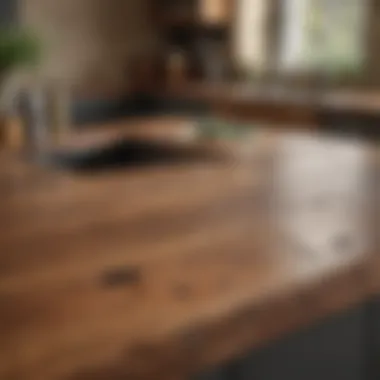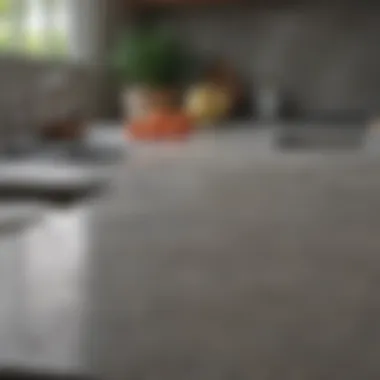Choosing the Right Material for Kitchen Countertops


Intro
The options for countertop materials are diverse, from natural stones like granite and marble to engineered surfaces like quartz and laminate. Each material has its unique properties, benefits, and drawbacks. Understanding these characteristics is essential for homeowners and design enthusiasts alike, as it helps ensure that functionality and style harmoniously align.
In this article, we will explore various materials suitable for kitchen countertops. We will provide in-depth analysis to help you select the best surface for your needs and preferences.
Let’s begin by examining some key insights and trends that are shaping the world of kitchen design today.
Key Insights and Trends
Current Trends in Interior Design
In recent years, the kitchen design landscape has evolved significantly. Homeowners are leaning towards materials that are not only beautiful but also sustainable and practical. Here are some key trends:
- Sustainable Materials: Eco-friendly options like bamboo and recycled glass are becoming more popular, reflecting a growing interest in environmentally conscious products.
- Mixed Materials: Combining different materials, such as wood and stone, is gaining traction. This approach adds dimension and character to kitchen spaces.
- Bold Colors and Patterns: Homeowners are opting for countertops in vibrant hues or unique patterns to create standout features in their kitchens.
These preferences indicate a shift from traditional designs to more personalized and functional spaces.
Practical Tips for Choosing Countertop Materials
When deciding on a countertop material, several factors deserve attention:
- Durability: Consider how much wear and tear the surface will face daily. Materials like quartz and granite excel in durability.
- Maintenance: Assess the level of maintenance you’re willing to commit to. Laminate requires less upkeep, while natural stones may need sealing.
- Cost: Budget determines many choices. While marble offers elegance, it is also more expensive than laminate or butcher block.
"A countertop should not only meet your design aspirations but also fit your lifestyle needs."
Before making a decision, it can be beneficial to visit home improvement stores or showrooms to see samples in person. This can help you better visualize how a material will integrate into your overall kitchen design.
Prelims to Kitchen Countertop Materials
Various materials present unique advantages and disadvantages that can impact the overall kitchen experience. Natural stones like granite and marble bring aesthetics and durability, while engineered stones such as quartz provide easier maintenance options. Furthermore, wood countertops can deliver warmth and character, although they require careful upkeep.
The choice of countertop material can vastly affect design appeal, practicality, and maintenance routine. Homeowners and interior design enthusiasts must weigh these factors against their specific needs and preferences. Here are a few significant reasons why delving into kitchen countertop materials is vital:
- Durability: Different materials offer varying levels of resistance to scratches, heat, and stains, which can affect longevity and daily usability.
- Maintenance: Some countertop surfaces require more maintenance than others. Understanding how to care for each type can influence its long-term viability and appearance.
- Cost: Budget constraints play a significant role in material selection. Knowing the pricing can help narrow down choices to fit financial plans.
- Aesthetic Value: The visual appeal of a countertop influences the overall atmosphere of the kitchen. Various materials can align or contrast with existing decor styles.
- Environmental Considerations: With a growing emphasis on sustainability, many homeowners are inclined to select materials that have a lower environmental impact.
"The material you choose for your kitchen countertop is not just about aesthetics. It must also align with your lifestyle and cooking habits."
In summary, the exploration of countertop materials encompasses an array of factors that ultimately define both the look and functionality of the kitchen space. As this article unfolds, we will analyze the nuances of different materials, equipping you with the insight required for making an informed choice.
Natural Stone Countertops
Natural stone countertops are highly regarded in kitchen design due to their unique properties and appeal. Homeowners often seek the durability and beauty that natural stone can provide. These materials, including granite, marble, soapstone, and quartzite, each possess distinct characteristics that make them suitable for the kitchen environment. Understanding these elements helps in making an informed choice that balances aesthetics with practicality.
Granite
Durability
Granite is known for its remarkable durability. This stone is a product of volcanic activity, making it extremely resistant to wear and tear. Homeowners appreciate durability because it indicates that a countertop can withstand heavy use. One unique feature of granite’s durability is that it can resist scratching and chipping, which is beneficial in a busy kitchen environment. Therefore, granite is often a popular choice for those looking for a long-lasting option.
Maintenance Requirements
The maintenance of granite countertops is another crucial aspect to consider. They require regular sealing to prevent stains from oils and acids typically found in kitchens. Although this may seem like a chore, it is relatively simple. Many find that a well-maintained granite surface can last for many years without significant issues. However, neglecting to seal it may lead to staining, which can be a disadvantage for homeowners who might not want to commit to such upkeep.
Cost Considerations
Cost is a significant factor in choosing granite. Prices can vary widely based on quality and origin. Generally, granite is considered an expensive material due to its extraction and fabrication costs. However, many homeowners view this as a worthy investment. The unique patterns and colors available can enhance the kitchen's overall appeal. It can be a nonlinear expense, as its value may increase with time if well maintained.
Marble
Beauty and Aesthetics


Marble countertops are celebrated for their stunning beauty and elegance. They often feature unique veining patterns that add character to kitchen spaces. This aesthetic appeal is one reason many homeowners opt for marble despite the potential drawbacks. The unique feature of marble is that it can elevate the look of any kitchen, making it visually impressive. However, its attractiveness can be somewhat misleading, as it requires more care than other stones.
Longevity and Hardness
While marble is durable, it is not as hard as granite. This makes it more susceptible to scratches and chips, especially in high-traffic areas. Longevity, therefore, might be compromised in fast-paced kitchens. However, if treated gently, marble can last many years. Its unique ability to age beautifully can appeal to homeowners who appreciate a patina effect over time.
Staining and Scratching Issues
Marble is porous, making it vulnerable to stains, particularly from acidic substances like citrus. This fact limits its practicality in some kitchen settings. Homeowners may need to be cautious about spills and clean them immediately. Some find these staining and scratch concerns dissuade them from selecting marble. However, with routine maintenance, such issues may be mitigated, ensuring a compelling and long-lasting aesthetic.
Soapstone
Resistance to Heat and Chemicals
Soapstone is famed for its excellent resistance to heat and chemicals. This characteristic is beneficial for those who cook frequently, as hot pots and pans can be placed directly on the surface without fear of damage. Unlike granite and marble, soapstone does not require sealing, which simplifies the maintenance process. This unique trait makes it practical for kitchens that see a lot of action.
Care and Maintenance
In terms of maintenance, soapstone is relatively low-maintenance. It does not stain easily and only needs occasional oiling to enhance its appearance. Some homeowners appreciate this feature as it reduces the workload associated with caring for the countertop. However, it can scratch more easily, which may be a concern for those who prefer a perfectly pristine surface.
Cost Overview
The cost of soapstone is generally competitive. However, prices can fluctuate based on quality and availability. Some may find soapstone more affordable than other natural stones with similar properties. The unique look can also add uniqueness to the kitchen at a reasonable price, making it appealing for many.
Quartzite
Stain Resistance
Quartzite is increasingly popular among homeowners. Its stain resistance is a key attribute, making it an attractive alternative to marble. Unlike marble, quartzite does not stain easily, which can be advantageous in busy kitchens. This characteristic allows for a more relaxed approach to food preparation, reducing the concern over spills.
Appearance and Finishing
The appearance of quartzite is another major draw for homeowners. It typically mimics the rich aesthetics of marble with unique textures and colors. Its ability to be polished to a high shine adds to its charm. This polished look is advantageous for those who desire elegance without compromising on durability, presenting a perfect blend of aesthetics and practicality.
Installation Concerns
Quartzite can be difficult to install due to its hardness. Special equipment and professional care are often needed, which can increase labor costs. While its durability is a selling point, the complexities involved in installation should be considered carefully. For some, this may deter them from choosing quartzite, despite its appealing qualities.
Engineered Stone Countertops
Engineered stone countertops are a significant category within the realm of kitchen surfaces. These materials combine natural stone with resins, enhancing their structural integrity and flexibility in design. When discussing kitchen countertops, it's crucial to consider engineered stone as it offers both aesthetic appeal and practical advantages, making it a lasting choice for homeowners. The primary benefits lie in their durability and variety of designs, which facilitate tailored solutions for various culinary and aesthetic needs. This section will delve into quartz and recycled materials, both integral parts of the engineered stone category.
Quartz
Composition and Fabrication
The composition of quartz countertops includes about 90% crushed stone and 10% polymer resins. This mixture makes them both strong and visually pleasing. The fabrication process involves compacting these materials under high pressure, resulting in a dense slab that is nearly non-porous. This characteristic contributes significantly to their popularity; homeowners valuing cleanliness will appreciate the prevention of bacterial growth due to the non-porous surface. Moreover, this composition allows for a variety of colors and patterns, ensuring there is something for every kitchen style. While they are generally seen as resilient, it is important to note that heat sources can damage the resin, necessitating care around hot cookware.
Design Versatility
One of the notable aspects of quartz countertops is their design versatility. Unlike natural stones that may have inherent variations, quartz can be manufactured to achieve a wide range of colors and textures. This makes it exceptionally appealing for modern kitchens seeking a cohesive look. The uniformity in design allows for seamless integration across different areas of the kitchen. It ensures that homeowners can match their countertops with cabinetry or flooring easily, creating a harmonious environment. However, some traditionalists may prefer the unique, varied look of natural stone, viewing quartz as too uniform for certain designs.
Durability and Maintenance
Durability is another crucial feature of quartz countertops. They are resistant to scratches and chips, adding to their appeal for busy kitchens. This characteristic makes them suitable for high-traffic areas, where wear and tear are common. Maintenance is also relatively simple; they usually require only mild soap and water for cleaning. However, one must remain cautious about avoiding harsh chemicals that can damage the surface. Overall, quartz offers an excellent balance of aesthetics and functionality, making it a favored option among homeowners.
Recycled Materials
Environmental Impact
Recycled materials in countertops represent a growing trend towards sustainability. These countertops are made from post-consumer materials such as glass, wood, and even metal. The environmental impact of choosing such materials is generally positive, as it reduces waste and decreases the demand for new raw materials. Utilizing recycled components offers a unique approach that aligns with eco-conscious practices. This has made recycled materials a popular choice among homeowners looking to lessen their carbon footprint while renovating their kitchens. However, sourcing these materials can sometimes limit options in terms of colors and finishes compared to traditional stones.
Unique Aesthetic Options


The aesthetic value of recycled materials is another compelling reason for their popularity. Each piece often has its own character, with unique patterns and textures that tell a story of its previous life. This distinctiveness allows homeowners to create one-of-a-kind designs that stand out. Many artists and designers favor these materials for their creativity. However, this uniqueness may not align with every homeowner’s vision, particularly those seeking a more uniform look in their kitchens.
Cost vs. Benefit
Evaluating the cost versus benefit of recycled materials presents interesting considerations. While they can sometimes be more expensive than conventional options due to the processing and shipping of materials, the long-term benefits can outweigh these costs. Homeowners investing in recycled surfaces often do so to embrace sustainability, which can add indirect value to their property. However, it is essential to assess individual needs and budget constraints, as the initial investment can deter some buyers when weighed against standard materials.
Investing in engineered stone countertops reflects a thoughtful approach to both beauty and functionality in the kitchen.
Wood Countertops
Wood countertops provide a unique blend of warmth and character in kitchen design. Their natural appeal makes them a favorite among many homeowners. They serve not only as a functional surface but also as a design statement. Additionally, wood countertops can fit various styles, from rustic to contemporary kitchens. They offer benefits that can enhance the kitchen experience, but some considerations must be addressed when selecting them.
Hardwoods
Visual Appeal and Warmth
Hardwoods like oak, maple, or cherry create an inviting atmosphere in any kitchen. This warmth is often associated with the comfort of home and family gatherings. Hardwoods are known for their distinctive grain patterns. Each piece tells its story, adding character to the kitchen. This aesthetic quality makes hardwood countertops a popular choice for those seeking a combination of beauty and functionality. However, their natural look requires regular maintenance to ensure they remain vibrant over time.
Care and Maintenance Needs
Wood countertops require careful attention. Regular oiling helps maintain the wood's appearance and prevents drying. Sealing is essential to protect against moisture and stains, which can damage the wood. While this maintenance may seem like an inconvenience, it often helps homeowners appreciate their countertops more. Proper care can prolong the life of the countertop. Users should expect to reapply sealant every six months to a year, depending on usage and care practices.
Potential Drawbacks
Despite their advantages, wood countertops have potential drawbacks. They can be susceptible to scratching and gouging from knives or heavy objects. Water damage is a significant concern if spills are not cleaned up promptly. Additionally, they may not be ideal for high-traffic cooking environments. It's vital to understand these limitations and consider them when deciding on this material. Homeowners looking for durability over aesthetics might need to look elsewhere.
Butcher Block
Usage in Meal Preparation
Butcher block countertops are specifically designed for meal preparation. They provide a sturdy surface for cutting and chopping, which is essential for any kitchen task. This practicality makes them a favorite among home cooks who prioritize function. Butcher block is also generally easier on knife edges compared to harder materials. However, maintaining cleanliness can be crucial, as wood can harbor bacteria if not cared for properly.
Sealing and Care
Butcher block countertops also require sealing to protect against moisture and staining. Regular oil application ensures the wood remains hydrated and free from damage. However, sealing is not a one-time task. It must be repeated periodically to maintain its protective barrier. This factor can be seen as a commitment for the user and is vital for longevity.
Cost Factors
Cost is an essential consideration when choosing butcher block countertops. Prices can vary significantly based on wood type and thickness. Generally, a thicker butcher block comes at a higher price point, indicating quality and durability. While they are often less expensive than stone options, budget considerations play a significant role in decision-making. It's important to factor in potential maintenance costs over time as well.
Alternative Materials
In the quest for a perfect kitchen countertop, alternative materials present unique options. These materials often stand out due to their aesthetics and functionality and may be suitable for various budgets. Understanding these alternatives is crucial to making an informed decision. The choices one makes can impact not just the kitchen's look but also usability and overall experience.
Concrete
Concrete countertops are becoming more popular in modern kitchens. Their strength and versatility can cater to different design needs.
Customization Options
One key aspect of concrete countertops is their customization. Homeowners can choose the color, texture, and even finish. This level of customization allows for a truly unique countertop. Moreover, artists can embed materials like glass or stones for added character. This ability to personalize makes concrete an appealing choice for those looking to create a standout feature in their kitchen.
Durability Concerns
Concrete is known for its incredible strength. However, it can also be prone to cracking if not installed correctly. It is essential to ensure proper installation to minimize this risk. Sealing concrete countertops can further enhance their durability and resistance to staining. While they hold up well under everyday use, maintenance is vital to preserve their appearance.
Installation Challenges
Installing concrete countertops can be complicated. Proper preparation of the site is essential. Unlike other materials, concrete is often poured on-site, which requires skilled labor. Additionally, they can be heavy, needing adequate support in installation. These challenges might deter some homeowners but offer great rewards if done correctly.
Laminate


Laminate countertops are a staple in many kitchens due to their affordability and variety.
Affordability
One of the main advantages of laminate is its cost. Compared to natural stone or engineered options, laminate is budget-friendly. Homeowners can achieve a stylish look without overspending. Laminate can mimic the appearance of more expensive materials, giving a luxurious touch at a fraction of the price.
Design Limitations
While laminate comes in many designs, it does have limitations. The patterns and textures may not match the depth of natural materials. Some styles may wear over time, losing their appeal. This can lead to a less satisfying investment for some homeowners. It's important to consider how long the design will last before making a decision.
Durability Overview
Laminate countertops are resistant to scratches but can be easily damaged by heat and moisture. It is essential to take care when placing hot pots or cleaning with harsh chemicals. Regular maintenance can extend the life of laminate, but caution is necessary to prevent issues. For a busy kitchen, laminate may not hold up as well as other materials.
Stainless Steel
Stainless steel countertops provide a modern look, appealing for those who prefer a sleek aesthetic.
Modern Aesthetic
The modern aesthetic of stainless steel is unmatched. It offers a clean, professional look that suits contemporary kitchens. The shiny surface reflects light, making spaces appear larger and more inviting. Many chefs appreciate its design for its industrial feel.
Practicality in Cooking
Stainless steel is practical for cooking environments. It resists heat, making it ideal for placing hot pans directly on the surface. It also has a non-porous surface, preventing bacteria growth. For those who cook frequently, this feature is highly valued. It can easily be cleaned with common household cleaners, ensuring hygiene is maintained.
Cost and Maintenance
Stainless steel can be more expensive than other alternatives. However, it offers longevity that can justify the initial investment. Maintenance is straightforward, but it can scratch easily. As a result, care is needed to maintain its appearance. Homeowners should weigh the costs against the benefits for long-term satisfaction.
Key Factors in Choosing a Countertop Material
Selecting the right material for kitchen countertops is a critical choice that influences both the utility and the overall aesthetic of the space. Several key factors guide this decision-making process. Understanding these aspects leads to a countertop that aligns with user needs and complements your kitchen design. Here are the most important factors you should consider:
Functionality
Functionality remains at the forefront of countertop selection. Think about how the kitchen is used on a daily basis. Is there heavy food preparation involved? Will hot pans be placed directly on the surface? Each of these scenarios demands specific material characteristics. For instance, granite provides heat resistance and durability, while laminate can be vulnerable to scratches and heat damage. Your countertop should not only support everyday activities but also make your cooking experience efficient.
Aesthetic Appeal
The visual aspects of a countertop cannot be overlooked. The right material should harmonize with the kitchen's overall theme. Many prefer natural stones like marble for their elegance and luxurious appearance. On the other hand, engineered stones, such as quartz, offer a uniform look that appeals to modernist designs. Consider color, pattern, and texture of each material, as they contribute significantly to the personality of your kitchen. Even the finish applied to the material can alter how it interacts with light, so choose wisely to complement your space.
Budget Constraints
Budgeting is crucial when selecting countertop materials. Prices vary widely among materials and significantly impact the choice. For instance, quartz and granite can be substantially more expensive than laminate or butcher block. It’s necessary to determine how much you are willing to invest in your countertops, keeping in mind that cheaper materials may not offer longevity or performance. Create a budget and consider both the initial costs and potential long-term expenses such as maintenance and replacement.
Environmental Considerations
Choosing eco-friendly materials can make a significant difference. Options such as recycled materials and sustainably sourced wood are increasingly popular. Natural stone may come with significant shipping emissions. Investigating the environmental impact of each material can inform a more responsible purchase decision. This awareness extends beyond sustainability; it can also influence local regulations, community sentiment, and resale value.
Installation and Longevity
The ease of installation affects not just cost but also how quickly you can start enjoying your new countertop. Some materials require professional installation while others can be managed as a DIY project. Concrete, for example, can be poured on-site but often needs skilled craftsmanship. Furthermore, consider the lifespan of the material. While stainless steel may incur higher initial costs, its durability offers longer-term savings due to less frequent replacements. Evaluate not only materials' resistance to wear but also ease of repair. For example, minor scratches in quartzite may be easier to address than those in laminate.
In summary, balancing functionality, aesthetic appeal, budget constraints, environmental considerations, and installation with longevity is essential for effective countertop selection.
Understanding these key factors allows you to approach your kitchen design with clarity, leading to better decision-making on the countertop material that suits your lifestyle and vision.
Finale
In the context of kitchen design, the choice of countertop material is of paramount importance. This article has thoroughly examined several materials, each offering distinct characteristics, advantages, and limitations. Understanding these factors plays a key role in guiding homeowners and designers toward making informed selections that resonate with both aesthetics and functionality.
One critical aspect to consider is how the chosen material will impact the overall kitchen environment. For instance, natural stones like granite and marble not only provide durability but also add an element of luxury. Conversely, materials such as laminate and recycled surfaces may offer cost-effectiveness without compromising design aesthetics. Therefore, assessing individual priorities—whether they are centered around style, ease of maintenance, or budget—will lead to a more satisfying kitchen experience.
Moreover, the longevity of the selected material is another vital consideration. Materials that withstand wear and tear over time, like quartz or hardwoods, can enhance a kitchen's value and appeal over the long term. Understanding the implications of installation and the material’s compatibility with daily use will ensure that the selected countertop meets the practical demands of a kitchen setting.
"Choosing the right countertop material is not just about surface appearance; it's about creating a cohesive and functional space."
Finally, environmental considerations are also becoming increasingly relevant. With more homeowners showing interest in sustainability, opting for materials that support eco-friendly practices can influence their choice. For example, recycled materials contribute positively to environmental health without sacrificing style.



